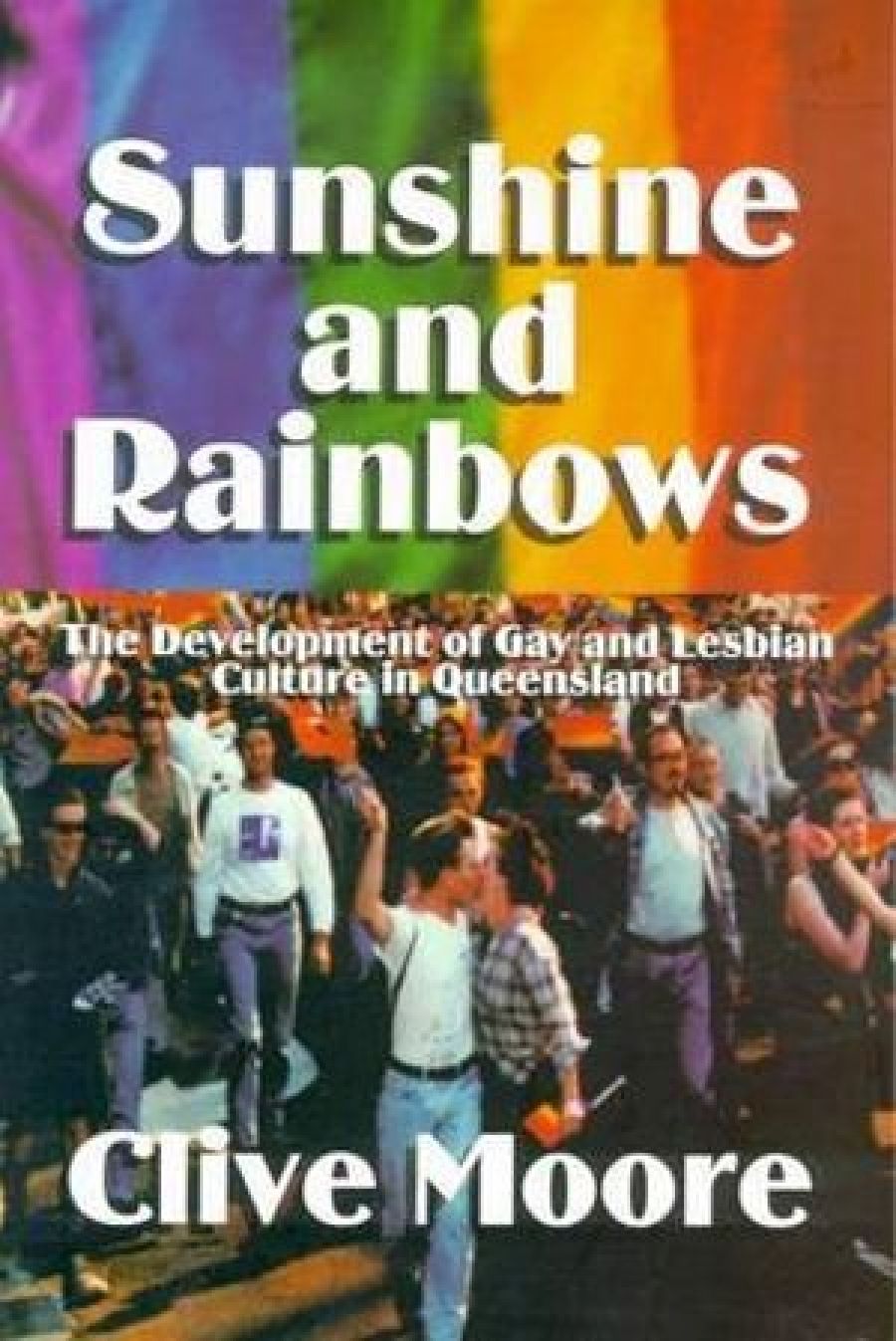
- Free Article: No
- Contents Category: Gay Studies
- Review Article: Yes
- Online Only: No
- Custom Highlight Text:
Living the queer life in the inner-city suburbs of Sydney, it is hard not to become complacent, smug even. Like a magnet, Sydney draws lesbians, gays, bisexuals, queers, you name it, from all over the country. If you’ve grown up in rural Victoria, moved to Melbourne after compulsory schooling, and then fifteen years later have hit a certain mid-gay-life ennui, where else is there to go?
- Book 1 Title: Sunshine and Rainbows
- Book 1 Subtitle: The development of gay and lesbian culture in Australia
- Book 1 Biblio: UQP, $30.00 pb, 24 4pp
Or so we Sydneysiders like to believe. Clive Moore’s admirable history of gay and lesbian life in Queensland, from the 1820s to the present, should puncture this Sydney-centric view of homosexual culture. Yes, queer life does exist beyond NSW, and very healthily too. In fact, Moore suggests that in the development of a gay and lesbian culture, it is Sydney that is out of kilter with the rest of the country. Queensland, he argues provocatively, is ‘the perfect paradigm ... to look at the transition in Australia from isolated homosexual acts and individuals, to a gay and lesbian subculture, and what. .. has in the 1990s become a culture in its own right’. Rebutting the thesis that Queensland is intrinsically different, Moore casts Queensland as ‘far more typical of Australia than are Sydney and New South Wales’. So if you really want to trace the history of homosexuality in Australia, forswear the seductive charms of Darlinghurst and Newtown, pack your bags, and head north.
The first hundred years of Moore’s history relies heavily upon court records and speculation, as any history of nineteenthcentury homosexuality must. Moore casts his net widely, from a verbatim reproduction of a sodomy case in Townsville in 1871 through to speculation about Robert Herbert, Queensland’s first Premier, and his romantic friendship with John Bramston. By not conclusively answering his own question – was Herbert gay? – Moore adroitly manages to have it both ways. He reclaims a significant, potential homosexual, whilst writing into his case study the historian’s dilemma of imposing contemporary sexual categories on the past.
This savvy distinguishes much of Sunshine and Rainbows. Moore knows his theory: feminist, gay/queer, race, and spatial. A quick look at the book’s bibliography confirms this. He is not content simply to write a history of homosexuality that runs adjacent to prevailing histories. Instead, Moore takes up the challenge of revealing, from the sexual margins, the dynamics of ‘mainstream’ Australian life. Thus, early chapters stress the historically specific nature of sexuality, the artificial dichotomy between heterosexuality and homosexuality, the contested and relational categories of masculinity and femininity, and the ways in which ‘deviant’ sexualities inform understandings of racial otherness.
How successfully Moore fulfils this ambitious task of reconstructing the dominant narratives of Australian history is open to debate. He has a tendency, especially in the first half of the book, to introduce a theoretical perspective in the opening paragraphs of a chapter, only to return to it substantially as he concludes. In between, there is much fascinating, empirical material that has been assiduously researched and well assembled. But the actual links between the theory and much of the evidence remain hazy.
Writing history that balances recent theory and good old-fashioned evidence is hard at the best of times - some would argue near impossible. Sunshine and Rainbows is constrained by its genesis in a series of thirty-five articles Moore wrote during the 1990s for Queensland Pride, the state’s leading gay and lesbian newspapers. Newspapers usually aren’t much concerned with theory. Gay newspapers, in particular, tend to solicit articles about the past that confirm a contemporary sense of identity and community, and I think this helps explain a certain tension in Moore’s book. In the concluding chapters, Moore finds a stronger, more daring voice as a contemporary observer.
Still, there is wonderful material in the case studies Moore presents. He is one of the first gay historians to focus on homosexuality in regional Australian with his mapping of gay and lesbian life in Cairns and Townsville. His ethnography of public sex cultures is outstanding, and his appreciation of the politics of public space acute. This is important, for too often historians have concentrated exclusively on recounting the history of official homosexual activism. Moore reminds us that the creation of a gay and lesbian culture was not the province of activists alone. Sex, and not just of the Sydney variety, needs to be written into gay and lesbian history, and in Sunshine and Rainbows, Moore has penned an impressive opener.


Comments powered by CComment